Discover a vibrant collection of 15 Asian dinner recipes that celebrate diverse regional flavors. Enjoy the fragrant Thai Green Curry with Chicken, savor the rich Indian Butter Chicken, or indulge in a comforting bowl of Japanese Ramen with Pork Chashu. Each dish highlights unique ingredients and cooking techniques, from the fresh herbs in Vietnamese Pho to the spicy notes in Bangladeshi Bhuna Beef. Explore these authentic recipes to elevate your culinary repertoire and uncover even more delightful dishes ahead.
Thai Green Curry With Chicken

Thai Green Curry with Chicken is a vibrant and aromatic dish that embodies the rich flavors of Thai cuisine. This dish is perfect for those who love a hint of spice and creamy coconut milk blended with fragrant herbs.
With a preparation time of around 10 minutes and a cooking time of 20 minutes, you can have a delicious homemade Thai meal ready in less than half an hour, making it ideal for busy weeknights or a cozy dinner with friends.
Ingredients:
- 1 lb (450g) chicken breast, thinly sliced
- 2 tablespoons green curry paste
- 1 can (400ml) coconut milk
- 1 tablespoon vegetable oil
- 1 cup chicken broth
- 1 cup mixed vegetables (bell peppers, zucchini, and carrots)
- 1 tablespoon fish sauce
- 1 tablespoon sugar
- Fresh basil leaves, for garnish
- Lime wedges, for serving
- Cooked jasmine rice, for serving
Cooking Steps:
- In a large skillet or wok, heat the vegetable oil over medium-high heat. Add the green curry paste and sauté for 1-2 minutes until fragrant.
- Add the sliced chicken to the skillet and cook for about 5 minutes until it is no longer pink on the outside.
- Pour in the coconut milk and chicken broth, stirring to combine everything. Bring the mixture to a gentle simmer.
- Add the mixed vegetables to the skillet and cook for an additional 5-7 minutes until the vegetables are tender but still vibrant in color.
- Stir in the fish sauce and sugar and let it simmer for another 2 minutes to combine the flavors.
- Taste and adjust seasoning if necessary, adding more fish sauce or sugar according to your preference.
- Remove from heat, and garnish with fresh basil leaves before serving.
Variations and Tips:
- For a vegetarian version, substitute chicken with tofu and use vegetable broth instead of chicken broth.
- Add citrusy flavor by incorporating lime juice or zest in the final steps for a fresh burst of flavor.
- Adjust the heat level by adding more or less green curry paste according to your taste preferences.
- Serve with jasmine rice or rice noodles to soak up the flavorful sauce.
- Feel free to experiment with other vegetables like eggplant or snap peas, adjusting cooking times as necessary.
- The Original Pro Chopper - Our superstar veggie slicer has been creating waves on TikTok! Simple to use,...
- Easy Meal Prep with Rust-Resistant Blades - Our vegetable chopper is perfect for anyone who wants to eat...
- 5-Star Design - The soft-grip TPU handle ensures controlled chopping, while the non-skid rubber base...
Japanese Ramen With Pork Chashu

Japanese Ramen With Pork Chashu is a comforting and flavorful dish that perfectly embodies the essence of Japanese cuisine. This rich and savory ramen features delicate noodles served in a fragrant broth, topped with tender, melt-in-your-mouth pork chashu, a braised pork belly that is beloved in Japan.
Ideal for a cozy dinner with family or a special date night, this dish requires a bit of preparation but delivers an authentic taste of Japan in roughly 2-3 hours, including the time needed for the chashu to marinate and cook.
Ingredients:
- 4 servings of fresh ramen noodles
- 500g pork belly (preferably skin-on)
- 4 cups chicken or pork broth
- 1 cup water
- 3 tablespoons soy sauce
- 2 tablespoons mirin (sweet rice wine)
- 1 tablespoon sake
- 1 tablespoon sugar
- 2 cloves garlic, minced
- 1-inch piece ginger, sliced
- 2 green onions, sliced (for garnish)
- Soft-boiled eggs (optional, for serving)
- Nori (seaweed sheets, for serving)
- Sesame seeds (for garnish)
Cooking Steps:
- Prepare the Chashu: Roll the pork belly tightly and tie it with kitchen twine to hold its shape. In a large skillet, combine soy sauce, mirin, sake, sugar, minced garlic, and sliced ginger. Add the pork belly to the skillet and pour in enough water to partially submerge the meat. Bring it to a boil, then reduce the heat to low. Cover and simmer for about 2 hours, turning the pork occasionally, until it's tender.
- Cook the Ramen Broth: In a separate pot, heat the chicken or pork broth along with a cup of water, and bring to a simmer. Add additional soy sauce or mirin to taste if desired.
- Prepare Soft-Boiled Eggs (optional): Bring a small pot of water to a boil. Gently add the eggs and cook for 6-7 minutes. Remove the eggs and place them in ice water to stop cooking. Once cooled, peel and set aside.
- Cook the Ramen Noodles: In a large pot of boiling water, cook the ramen noodles according to the package instructions until al dente. Drain and rinse under cold water to stop further cooking.
- Assemble the Ramen Bowl: In serving bowls, add a portion of ramen noodles. Ladle the hot broth over the noodles, and place slices of chashu on top. Halve the soft-boiled eggs and add to each bowl, along with sliced green onions and nori. Sprinkle with sesame seeds for extra flavor.
Variations and Tips:
- You can substitute pork belly with other meats like chicken thighs or even tofu for a vegetarian version.
- Experiment with toppings such as bamboo shoots, mushrooms, or corn to add more textures and flavors.
- For an extra kick, add chili oil or fresh chili slices for heat.
- If you prefer a richer broth, let the chashu simmer longer and make sure to skim any excess fat.
- Feel free to prepare homemade ramen noodles for an even more authentic experience, although store-bought is a great time-saving option.
Enjoy your homemade Japanese ramen with pork chashu, complete with all the flavors and aromas that transport you straight to Japan!
- Makes Everything Simple : Just forget your bagged cheese! Only turn the handle for several times and get...
- Premium Material : All parts of the rotary cheese grater are made of food grade ABS material, no BPA. The...
- Three Option Grater : The parmesan cheese grater finishes food preparation with slicing, shredding and...
Indian Butter Chicken

Indian Butter Chicken, or Murgh Makhani, is a rich and creamy dish that hails from Indian cuisine. It features succulent chicken pieces marinated in spices and yogurt, simmered in a velvety, buttery tomato sauce. This dish is perfect for families looking to indulge in a comforting meal or for entertaining guests at a dinner party.
Preparation time is approximately 20 minutes, while the cooking time can take about 30 minutes, making it a relatively quick yet elegant choice for any occasion.
Ingredients:
- 1 lb (450g) boneless, skinless chicken thighs, cut into bite-sized pieces
- 1 cup plain yogurt
- 2 tablespoons lemon juice
- 2 teaspoons garam masala
- 1 teaspoon turmeric powder
- 1 teaspoon chili powder (adjust for spice level)
- 1 teaspoon salt
- 4 tablespoons butter
- 1 onion, finely chopped
- 4 cloves garlic, minced
- 1 tablespoon ginger, minced
- 1 can (15 oz) tomato puree
- 1 cup heavy cream
- Fresh cilantro, for garnish
- Cooked basmati rice or naan, for serving
Cooking Steps:
- In a bowl, combine the yogurt, lemon juice, garam masala, turmeric, chili powder, and salt. Add the chicken pieces, ensuring they are well coated. Let them marinate for at least 30 minutes (or up to overnight in the fridge for more flavor).
- In a large skillet, melt 2 tablespoons of butter over medium heat. Add the chopped onions and sauté until they are translucent, about 5 minutes.
- Stir in the minced garlic and ginger, cooking for another minute until fragrant.
- Add the marinated chicken pieces to the skillet, cooking until they are browned on all sides (approximately 5-7 minutes).
- Pour in the tomato puree, stirring to combine. Reduce heat to low, cover, and simmer for about 15 minutes.
- After simmering, stir in the remaining butter and the heavy cream. Allow the sauce to reheat for another 5 minutes, adjusting seasoning as necessary.
- Garnish with fresh cilantro and serve hot with basmati rice or naan.
Variations and Tips:
- For a vegetarian version, substitute the chicken with paneer or vegetables like cauliflower and bell peppers.
- You can adjust the level of heat by increasing or decreasing the amount of chili powder according to your taste preference.
- To enhance the richness, consider adding a tablespoon of kasuri methi (dried fenugreek leaves) towards the end of cooking for an authentic touch.
- If time is tight, use a store-bought tikka masala sauce as a base but be sure to enhance it with butter and cream to get that signature butter chicken flavor.
- Leftover butter chicken can be stored in the fridge for up to 3 days and tastes even better the next day!
- 💰 REDUCE WASTE AND SAVE MONEY: Chef Preserve keeps FOOD FRESH 5 TIMES LONGER than non-vacuum storage...
- ✅ POWERFUL, QUICK & EASY TO USE: Simply press the button to start. The device vacuum seals a bag in 5...
- ♻️ REUSABLE & RESEALABLE BAGS: Chef Preserve comes with dishwasher, freezer, refrigerator, and...
Korean Bibimbap
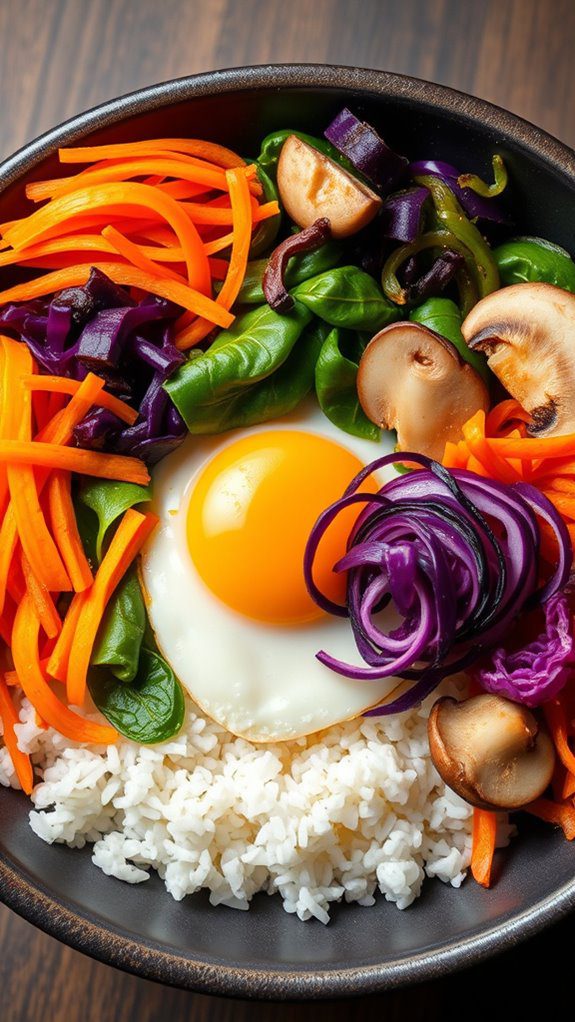
Korean Bibimbap is a vibrant and nutritious one-bowl dish that combines a variety of seasoned vegetables, rice, and often an egg, topped with a savory sauce called gochujang. This dish is perfect for anyone looking for a wholesome meal that's both satisfying and visually appealing.
It's ideal for families, gatherings, or even as a delightful solo meal. Preparation time for bibimbap is approximately 30-40 minutes, making it suitable for both weeknight dinners and special occasions.
Ingredients:
- 2 cups cooked white or brown rice
- 1 cup spinach, blanched and chopped
- 1 cup bean sprouts, blanched
- 1 carrot, julienned
- 1 zucchini, julienned
- 1 cup mushrooms (shiitake or button), sliced
- 1 egg (fried or poached)
- 2 tablespoons sesame oil
- 2 tablespoons gochujang (Korean chili paste)
- 1 tablespoon soy sauce
- 1 tablespoon sesame seeds
- Salt, to taste
- Optional: thinly sliced beef (bulgogi) or tofu for protein
Cooking Steps:
1. Prepare the Rice: Begin by cooking 2 cups of rice according to the package instructions. Allow it to cool while you prepare the vegetables.
2. Sauté the Vegetables:
- In a medium frying pan, heat 1 tablespoon of sesame oil over medium heat.
- Sauté the sliced mushrooms until they are tender, about 3-4 minutes. Season with salt to taste, then remove from the pan and set aside.
- Each of the remaining vegetables (spinach, bean sprouts, carrot, and zucchini) should be sautéed separately in the same pan for about 2-3 minutes to maintain their individual flavors and colors.
Season with salt and a drop of sesame oil if desired.
3. Prepare the Protein (optional): If using beef or tofu, prepare it by cooking it in the same pan with a little sesame oil. Cook until browned and cooked through, then set aside.
4. Fry the Egg: In the same pan, briefly fry the egg sunny-side up or to your desired doneness.
5. Assemble the Bibimbap:
- In a large bowl, place a serving of rice at the bottom.
- Arrange the sautéed vegetables on top of the rice in sections to create a colorful display.
- Place the fried egg in the center.
- Drizzle the dish with gochujang and add a sprinkle of sesame seeds.
6. Serve: Combine all ingredients together in the bowl before eating, ensuring the gochujang is mixed evenly throughout. Adjust seasoning with a little more soy sauce or gochujang according to your taste.
Variations and Tips:
- Vegetarian Version: Substitute meat with tofu or additional vegetables.
- Vegan Version: Omit the egg and replace it with avocado or additional tofu.
- Make It Spicy or Mild: Adjust the amount of gochujang based on your spice preference.
- Use Leftovers: Bibimbap is a great way to use up leftover vegetables or proteins from previous meals.
- Customize: Feel free to add other ingredients like seaweed, pickled radish, or other seasonal vegetables to suit your taste.
This Korean Bibimbap can be tailored to suit your preferences, making it a versatile and delightful dish that everyone will love!
- Generous Capacity: 7-quart slow cooker that comfortably serves 9+ people or fits a 7-pound roast
- Cooking Flexibility: High or low slow cooking settings, with convenient warm function for ideal serving...
- Convenient: Set it and forget it feature enables you to cook while at work or performing daily tasks
Vietnamese Pho
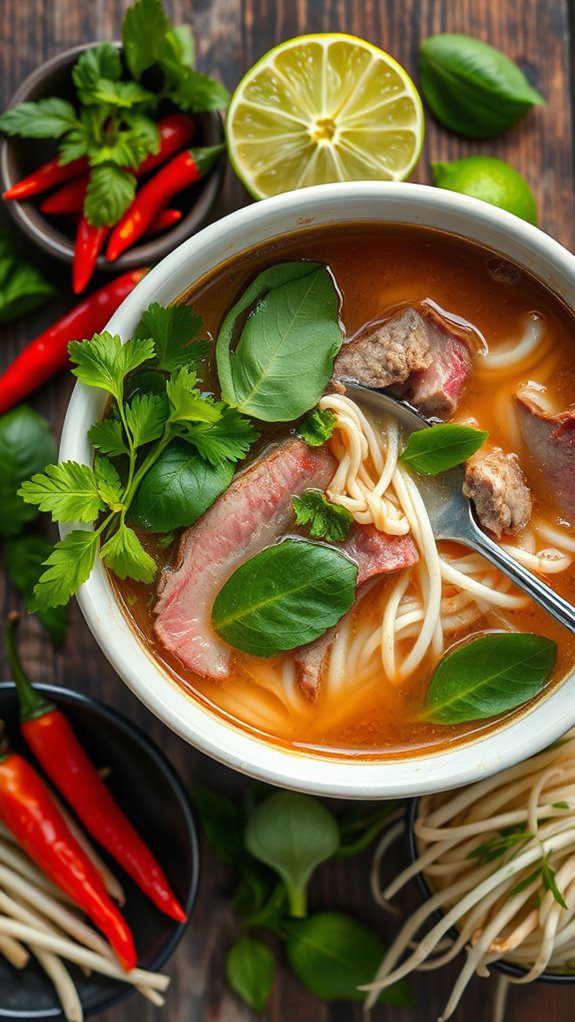
Pho is a traditional Vietnamese noodle soup that features a rich, aromatic broth, flat rice noodles, and various toppings, typically including meats like beef or chicken. This dish is not only comforting but also a delightful culinary journey, perfect for any occasion, from a cozy dinner at home to serving guests at a gathering. The preparation time for pho can take around 1.5 to 2 hours, including the time for making the broth and assembling the dish.
Ingredients:
- 2 pounds beef bones (or chicken bones for a lighter version)
- 1 onion, halved
- 1 ginger root, about 3 inches, halved lengthwise
- 5 star anise
- 4 cloves
- 1 cinnamon stick
- 1 tablespoon coriander seeds
- Salt, to taste
- 10 cups water
- 1 pound flat rice noodles (bánh phở)
- 1 pound sirloin or brisket, thinly sliced (or chicken)
- Fresh herbs (basil, cilantro, mint)
- Bean sprouts
- Lime, cut into wedges
- Hoisin sauce
- Sriracha sauce
- Green onions, chopped
Cooking Steps:
- Roast the Aromatics: Preheat your oven to 400°F (200°C). Place the halved onion and ginger on a baking sheet and roast for about 20 minutes until charred. This step enhances the flavor of the broth.
- Prepare the Broth: In a large pot, add the beef or chicken bones, roasted onion, and ginger, star anise, cloves, cinnamon stick, coriander seeds, salt, and water. Bring to a boil, then reduce to a simmer. Skim off any foam or impurities that rise to the top. Simmer for at least 1.5 hours to develop a deep flavor.
- Cook the Noodles: While the broth is simmering, cook the rice noodles according to the package instructions. Drain and rinse under cold water to prevent sticking. Set aside.
- Strain the Broth: Once the broth is ready, strain it through a fine mesh sieve into another pot to remove solids. Adjust seasoning with additional salt if needed.
- Assemble the Bowls: Divide the cooked noodles into bowls. Add the thinly sliced meat on top (it will cook in the hot broth). Ladle the piping hot broth over the noodles and meat.
- Garnish: Serve with fresh herbs, bean sprouts, lime wedges, hoisin, and Sriracha on the side for customization.
Variations and Tips:
- For a vegetarian version, substitute the beef or chicken with mushrooms, tofu, and vegetable broth.
- For extra flavor, consider adding a splash of fish sauce to the broth.
- To save time, bones can be prepped in advance or use pre-made stock as a base, adjusting the flavor with fresh aromatics.
- Pho can be customized with different proteins, such as meatballs, fish, or tofu, depending on your preferences.
Enjoy your homemade Vietnamese Pho, a bowl of warmth and happiness!
- 100% Leak-proof: Guaranteed no-spill seal and secure latches
- Crystal-clear Tritan Built: Stain-resistant and odor-resistant material for a clear view of contents
- Lightweight & Sturdy: Easy to carry, yet durable for everyday use
Malaysian Nasi Lemak
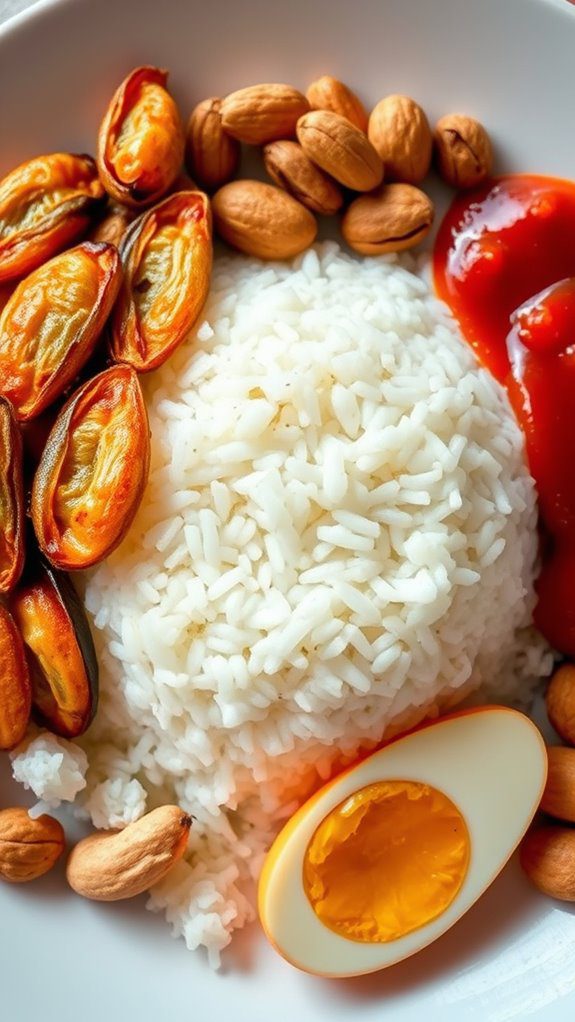
Nasi Lemak is a beloved Malaysian dish known as the nation's unofficial national dish. It consists of fragrant rice cooked in coconut milk, served with a variety of accompaniments such as sambal (spicy chili paste), fried crispy anchovies, toasted peanuts, boiled eggs, and cucumber slices.
This dish beautifully balances flavors and textures, making it a hearty meal perfect for breakfast, lunch, or dinner. Preparing Nasi Lemak takes about 1.5 hours, including cooking time and ingredients preparation.
Ingredients:
- 2 cups of jasmine rice
- 1 can (400ml) of coconut milk
- 1 1/2 cups of water
- 1 pandan leaf, knotted (optional)
- 1 teaspoon of salt
- 1 cup of fried crispy anchovies (ikan bilis)
- 1 cup of roasted peanuts
- 2 hard-boiled eggs
- 1 cucumber, sliced
- 1 cup of sambal (store-bought or homemade)
Cooking Instructions:
- Rinse the jasmine rice under cold water until the water runs clear. Drain well.
- In a rice cooker or pot, combine the rinsed rice, coconut milk, water, salt, and the knotted pandan leaf. Cook according to your rice cooker instructions, or bring to a boil, then reduce to a simmer, cover, and cook for about 20 minutes on the stovetop until the rice is tender and the liquid is absorbed.
- While the rice is cooking, prepare the accompaniments. Fry the anchovies until they are crisp, and set aside. Boil the eggs in a pot of water for 10-12 minutes, then cool and slice them in half.
- Once the rice is cooked, fluff it with a fork. Remove the pandan leaf (if used) and serve the rice on a plate.
- Arrange the fried anchovies, roasted peanuts, boiled eggs, cucumber slices, and a generous portion of sambal around the rice.
Variations and Tips:
- For an authentic touch, you can add fried chicken or rendang (spicy meat dish) as a protein topping.
- You can adjust the spiciness of the sambal according to your preference, using less or more chili.
- If you prefer a vegetarian version, omit the anchovies and replace them with tofu or tempeh.
- Garnish with additional herbs like cilantro or fried shallots for extra flavor and presentation.
- Make the dish ahead of time, and store components separately in the refrigerator; it can be reheated for a quick meal!
- 𝗘𝗳𝗳𝗼𝗿𝘁𝗹𝗲𝘀𝘀 𝗪𝗲𝗶𝗴𝗵𝗶𝗻𝗴: Supports 5 units...
- 𝗣𝗿𝗲𝗰𝗶𝘀𝗲 𝗥𝗲𝘀𝘂𝗹𝘁𝘀: Accurately weighs up to 11 lb/5 kg with 1 g...
- 𝗦𝗶𝗺𝗽𝗹𝗲 & 𝗖𝗼𝗺𝗽𝗮𝗰𝘁: The small and sleek scale is a perfect fit for...
Chinese Kung Pao Chicken

Kung Pao Chicken is a classic Chinese dish that features a delightful combination of tender chicken pieces, crunchy peanuts, and vibrant vegetables, all tossed in a spicy and savory sauce.
Originating from Sichuan province, this dish is ideal for those who enjoy bold flavors and a bit of heat. It's perfect for family dinners or gatherings, as it can be prepared in about 30 minutes, making it a great choice for busy weeknights.
Ingredients:
- 1 pound boneless, skinless chicken thighs, cut into bite-sized pieces
- 3 tablespoons soy sauce
- 1 tablespoon rice vinegar
- 1 tablespoon cornstarch
- 2 tablespoons vegetable oil
- 3-4 dried red chilies (adjust to taste)
- 1 bell pepper, diced
- 1 cup unsalted roasted peanuts
- 2 green onions, sliced
- 3 cloves garlic, minced
- 1-inch piece ginger, minced
- 1 tablespoon hoisin sauce
- 1 tablespoon sesame oil
- Salt to taste
Cooking Steps:
- In a mixing bowl, combine the chicken pieces with soy sauce, rice vinegar, and cornstarch. Mix well and let marinate for at least 10 minutes.
- Heat the vegetable oil in a large skillet or wok over medium-high heat. Add the dried red chilies and stir-fry for about 30 seconds until fragrant.
- Add the marinated chicken to the skillet, and stir-fry for about 5-7 minutes until the chicken is cooked through and slightly browned.
- Stir in the garlic, ginger, diced bell pepper, and cook for another 2-3 minutes until the bell pepper is just tender.
- Add in the peanuts, hoisin sauce, and sesame oil; mix well to coat all the ingredients. Season with salt if necessary.
- Finally, fold in the sliced green onions, and stir-fry for an additional minute before removing from heat.
Variations and Tips:
- For a vegetarian option, substitute chicken with tofu or tempeh.
- Feel free to add more vegetables such as broccoli, snap peas, or carrots for added nutrition.
- Adjust the level of heat by using fewer or more dried red chilies, or consider using fresh red chili for a different flavor profile.
- Serve over steamed rice or noodles for a complete meal.
- If you like it saucier, add a splash of chicken or vegetable broth and a little more cornstarch mixed with water to create a thickened sauce.
- Instant Read Food Thermometer | Our instant read thermometer features a temperature probe and advanced,...
- Multi-Use | From bbq thermometer to baking thermometer, our digital food thermometer for cooking is...
- Easy-Read Digital Thermometer For Cooking | Large instant thermometer dial with bright blue backlight...
Indonesian Nasi Goreng
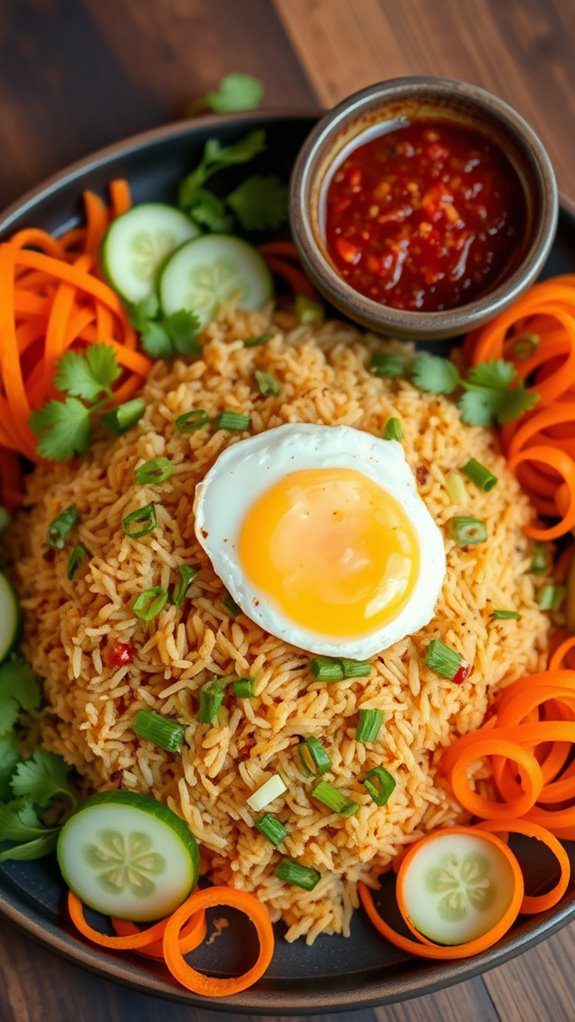
Nasi Goreng is a quintessential Indonesian fried rice dish, renowned for its savory and slightly spicy flavor profile. Perfect for serving a family, guests or even as a quick weeknight meal, this dish is versatile and can be customized with a variety of proteins and vegetables.
With a preparation time of just 20 minutes, Nasi Goreng is an excellent choice for both novice and experienced cooks looking to transport their taste buds to Southeast Asia.
Ingredients:
- 2 cups cooked jasmine rice (preferably refrigerated)
- 2 tablespoons vegetable oil
- 2 cloves garlic, minced
- 1 small onion, diced
- 1 red chili, sliced (adjust to taste)
- 2 eggs, lightly beaten
- 100g shrimp or chicken, diced (optional)
- 1 cup mixed vegetables (carrots, peas, bell peppers)
- 3 tablespoons kecap manis (sweet soy sauce)
- 1 tablespoon soy sauce
- Salt and pepper to taste
- Green onions, chopped (for garnish)
- Fried shallots (optional, for garnish)
- Cucumber and tomato slices (for serving)
Cooking Steps:
- Prepare the Rice: If using freshly cooked rice, spread it out on a plate and let it cool for a few minutes. Cold rice works best for frying.
- Heat the Oil: In a large frying pan or wok, heat the vegetable oil over medium-high heat.
- Sauté Aromatics: Add minced garlic and diced onion to the hot oil. Stir-fry for about 1-2 minutes until fragrant and translucent.
- Add Protein: If you're using shrimp or chicken, add it to the pan now, cooking until fully cooked (about 3-4 minutes).
- Cook the Eggs: Push the mixture to one side of the pan and pour in the beaten eggs on the other side. Scramble the eggs until set, and then combine with the other ingredients.
- Mix in Rice: Add the cold rice to the pan. Use a spatula to break up any clumps and toss it with the mixture thoroughly.
- Season: Pour in the kecap manis and soy sauce, then season with salt and pepper. Continue to stir-fry for an additional 3-4 minutes until everything is heated through.
- Add Vegetables: Toss in the mixed vegetables and stir-fry for another 2 minutes until they're tender but still crisp.
- Serve: Garnish with chopped green onions and fried shallots, and serve with cucumber and tomato slices on the side.
Variations and Tips:
- For a vegetarian option, substitute shrimp or chicken with tofu and use plant-based sauces.
- Customize the heat level by adjusting the amount of chili used or adding sambal oelek for extra spice.
- Feel free to add toppings like a fried egg on top for a beautiful presentation.
- Leftover rice should ideally be used for the best texture; freshly cooked rice may become mushy during frying.
- Experiment with different vegetables based on your preference or seasonal availability.
Enjoy your homemade Nasi Goreng; it's a delightful mix of flavors and textures that will surely satisfy your hunger!
- Versatile 54-Piece Collection: Elevate your kitchen with the Home Hero 54-Piece Kitchen Utensil Set, a...
- Durable and Long-Lasting: Crafted from premium stainless steel, these kitchen utensils are designed to...
- Perfect Holiday Gift: Delight your loved ones with this kitchen utensils gift set this festive season....
Filipino Adobo
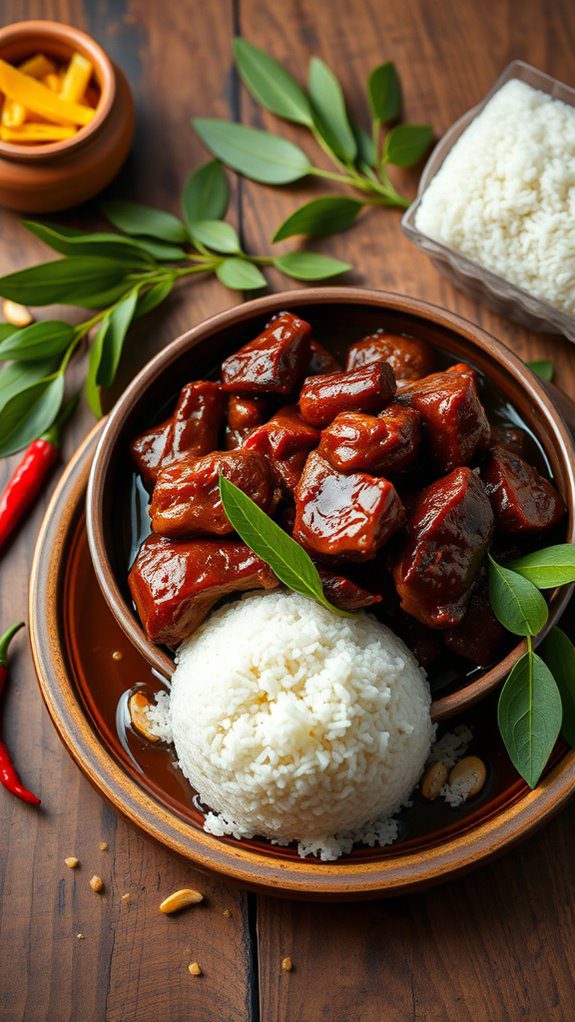
Filipino Adobo is a classic and beloved dish that showcases the bold and savory flavors of Filipino cuisine. This dish typically features meat simmered in a marinade of vinegar, soy sauce, garlic, and spices, resulting in a rich and tangy flavor profile. It is ideal for families and gatherings, making it perfect for a hearty dinner. The preparation time is approximately 15 minutes with a cooking time of 1 to 1.5 hours, depending on the meat used.
Ingredients
- 2 lbs chicken thighs or pork belly (or a combination of both)
- ½ cup soy sauce
- ½ cup white vinegar
- 1 head garlic, minced
- 2 bay leaves
- 1 teaspoon black peppercorns
- 2 tablespoons vegetable oil
- 1 cup water
- Salt to taste
- Optional: 2-3 boiled eggs for garnish
Cooking Steps
- In a large bowl, combine the chicken or pork with soy sauce, vinegar, minced garlic, bay leaves, and black peppercorns. Marinate for at least 30 minutes, or up to 24 hours in the refrigerator for deeper flavor.
- Heat the vegetable oil in a large pot or Dutch oven over medium heat. Remove the meat from the marinade, reserving the marinade, and sear the meat in the hot oil until browned on all sides.
- Pour the reserved marinade and water into the pot with the seared meat. Bring to a boil, then reduce the heat to low and cover.
- Simmer for about 30 to 40 minutes for chicken or 1 hour for pork, or until the meat is tender, stirring occasionally. Add more water if necessary to prevent the sauce from drying out.
- Once cooked, taste and adjust seasoning with salt, if desired. For a thicker sauce, remove the lid and let the adobo simmer uncovered for an additional 10-15 minutes.
- Serve the adobo hot, garnished with boiled eggs if desired, over steamed rice.
Variations and Tips
- You can experiment with different meats such as beef, duck, or even tofu for a vegetarian option.
- Add vegetables such as potatoes or carrots during the last 20 minutes of cooking for a heartier meal.
- If you prefer a sweeter adobo, add a tablespoon of sugar or coconut milk to the marinade.
- To enhance flavor, consider adding chili peppers for some heat or fresh herbs like cilantro as a garnish.
- Leftovers taste even better the next day as the flavors continue to meld; they can be stored in the refrigerator for up to three days.
- 24-ounce insulated stainless-steel water bottle with a FreeSip spout and push-button lid with lock
- Patented FreeSip spout designed for either sipping upright through the built-in straw or tilting back to...
- Protective push-to-open lid keeps spout clean; convenient carry loop doubles as a lock
Singaporean Chili Crab
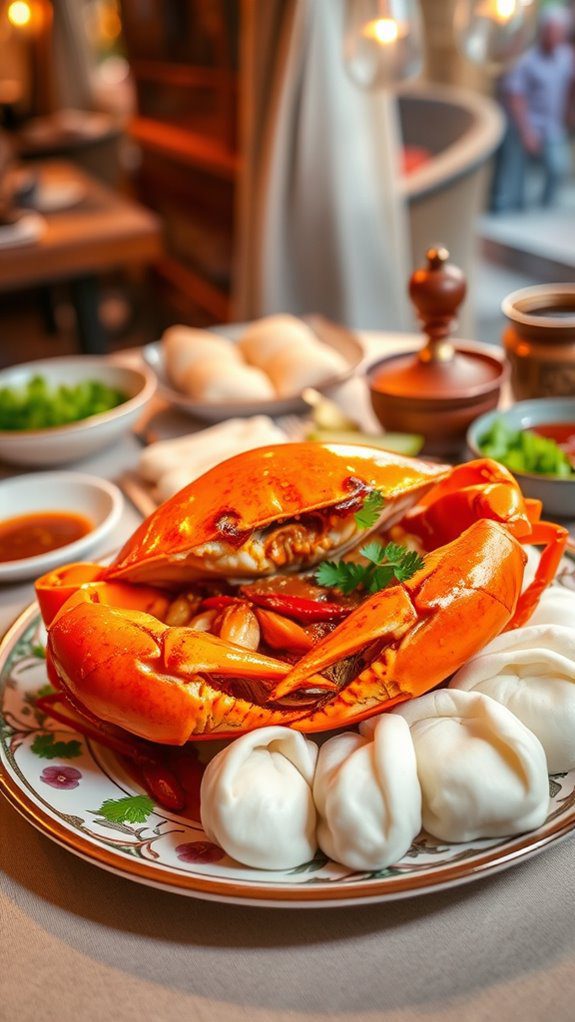
Singaporean Chili Crab is a flavorful, spicy dish that features tender crab cooked in a rich, tangy sauce. It is a beloved delicacy in Singapore and is ideal for seafood lovers and those looking to impress their guests with an extravagant meal.
The preparation time for this dish is approximately 20 minutes, with a cooking time of 30-45 minutes, making it perfect for a special occasion or a weekend feast.
Ingredients:
- 2 large crabs (cleaned and halved)
- 2 tablespoons vegetable oil
- 6 cloves garlic (minced)
- 1 piece ginger (about 2 inches, minced)
- 2-3 red chilies (slashed)
- 1 cup tomato puree
- 1/4 cup chili sauce
- 2 tablespoons soy sauce
- 1 tablespoon oyster sauce
- 2 teaspoons sugar
- 1 teaspoon vinegar (white or rice)
- 2 beaten eggs
- Fresh coriander leaves (for garnish)
- Steamed buns or rice (for serving)
Cooking Steps:
- Heat the vegetable oil in a large wok or deep pan over medium heat. Add the minced garlic and ginger, and sauté until fragrant.
- Stir in the slashed red chilies, then add the tomato puree, chili sauce, soy sauce, oyster sauce, sugar, and vinegar. Blend well and bring the mixture to a simmer.
- Carefully add the cleaned crab halves to the wok, turning them to coat in the sauce. Cover and cook for about 20 minutes, stirring occasionally, until the crab is fully cooked and bright orange.
- Gradually pour in the beaten eggs while stirring gently to create a silky texture in the sauce. Allow it to cook for an additional 2-3 minutes.
- Remove from heat and garnish with fresh coriander leaves before serving.
Variations and Tips:
- For additional heat, include more chopped red chilies or a dash of chili oil.
- If you prefer a smoother sauce, you can blend the sauce ingredients before adding the crab.
- Substitute crab with other seafood like prawns or lobster for a variation of seafood dishes.
- Serve the chili crab with steamed buns or fluffy rice to soak up the flavorful sauce.
- Remember to have plenty of napkins on hand; this dish can get messy but is so delicious you'll be glad you indulged!
Burmese Mohinga
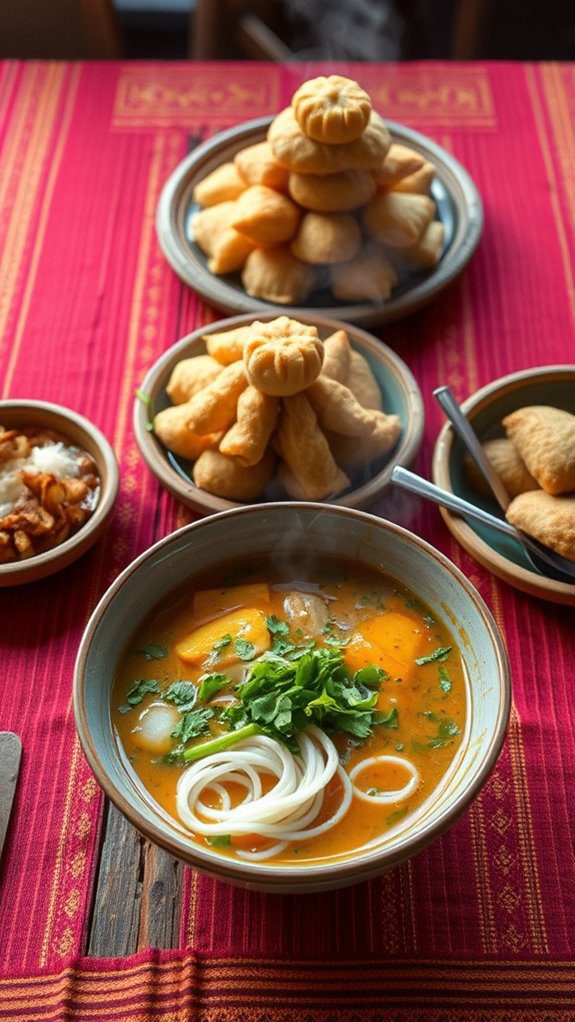
Mohinga is a traditional Burmese dish, often considered the national dish of Myanmar. This flavorful fish soup is typically enjoyed for breakfast, but it can be served at any meal. Its rich combination of spices, lemongrass, and fish creates a fragrant broth that is both comforting and satisfying.
Preparation time is approximately 20 minutes, with an additional cooking time of 30-40 minutes, making it a great option for those looking to warm up on a cool day or impress guests with a taste of Southeast Asian cuisine.
Ingredients:
- 1 lb (450g) catfish or other white fish
- 8 cups water
- 1 stalk lemongrass, chopped
- 1 onion, diced
- 4 cloves garlic, minced
- 1 thumb-sized piece of ginger, sliced
- 1 teaspoon turmeric powder
- 1 tablespoon fish sauce
- 1 tablespoon tamarind paste (or juice)
- 1 teaspoon salt (or to taste)
- 1 tablespoon vegetable oil
- 1 cup rice noodles
- 2 boiled eggs, sliced (for garnish)
- 1/4 cup chopped cilantro (for garnish)
- 1/4 cup sliced green onions (for garnish)
- Lemon wedges (for serving)
- Chili flakes (optional, for serving)
Cooking Steps:
- In a large pot, combine the water, fish, lemongrass, onion, garlic, ginger, turmeric, fish sauce, tamarind paste, and salt. Bring to a boil over medium-high heat.
- Reduce the heat to low and let it simmer for about 30 minutes, or until the fish is cooked through. Remove the fish, set aside, and allow it to cool slightly before shredding it.
- In a separate pot, cook the rice noodles according to package instructions. Drain and set aside.
- Use a sieve to strain the soup broth, discarding the solids and returning the liquid to the pot. Adjust seasoning if necessary.
- To serve, place a portion of the cooked rice noodles in a bowl, ladle hot broth over the noodles, and top with shredded fish, sliced boiled eggs, cilantro, and green onions.
- Serve with lemon wedges and sprinkle with chili flakes for added heat, if desired.
Variations and Tips:
- You can substitute catfish with other types of fish such as tilapia or trout.
- For a vegetarian version, replace fish with tofu and vegetable broth, ensuring to adjust seasonings accordingly.
- Add more vegetables, like bok choy or spinach, to the broth for added nutrition.
- For a more intense flavor, consider adding a couple of dried shrimp or other seafood while simmering the broth.
- Adjust the level of tamarind paste to balance the soup's tanginess according to your preference.
- Mohinga can be made ahead of time and reheats well, making it a perfect dish for meal prep.
Bangladeshi Bhuna Beef
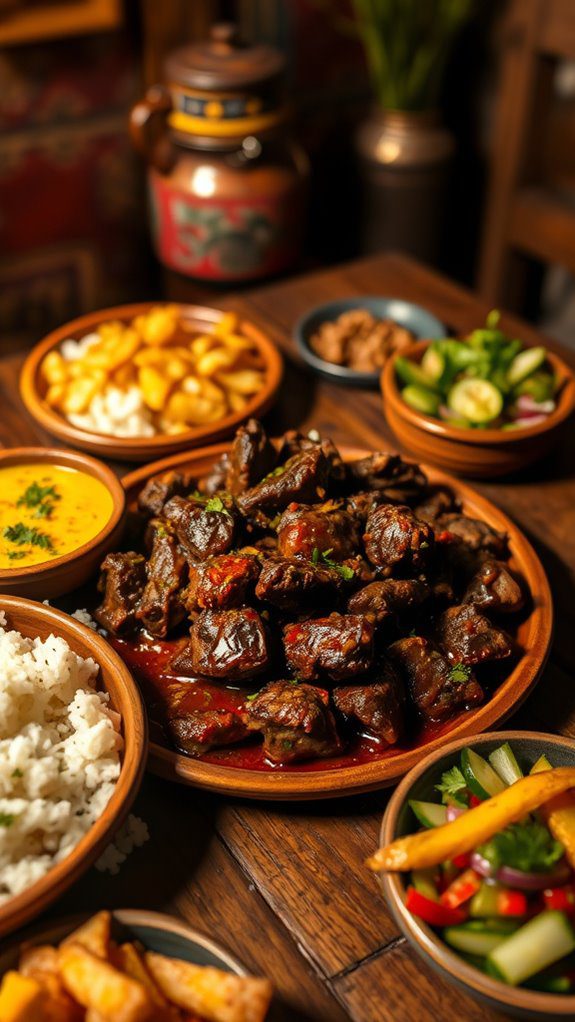
Bhuna Beef is a classic Bangladeshi dish renowned for its rich flavors and aromatic spices. It is a slow-cooked beef curry where the meat is sautéed until browned and then simmered with a blend of spices, creating a deeply flavorful sauce. This dish is perfect for family gatherings, special occasions, or simply a comforting dinner at home.
The preparation time is approximately 20 minutes, with a cooking time of about 1.5 to 2 hours for the meat to become tender and absorb the aromatic spices.
Ingredients
- 2 lbs beef (cut into cubes)
- 4 tablespoons vegetable oil
- 1 large onion (finely sliced)
- 4-5 cloves garlic (minced)
- 1-inch piece ginger (grated)
- 2-3 green chilies (slit)
- 2 teaspoons turmeric powder
- 2 teaspoons chili powder
- 2 teaspoons cumin powder
- 2 teaspoons coriander powder
- 1 teaspoon garam masala
- 1 large tomato (chopped)
- Salt (to taste)
- Fresh cilantro (for garnish)
- Water (as needed)
Cooking Steps
- Heat the Oil: In a large pan or heavy-bottomed pot, heat the vegetable oil over medium heat.
- Sauté Onions: Add the sliced onions and sauté until they become golden brown. This step is essential as it develops the base flavor of the dish.
- Add Garlic and Ginger: Stir in the minced garlic, grated ginger, and slit green chilies. Cook for another 2-3 minutes until fragrant.
- Add Spices: Incorporate the turmeric, chili powder, cumin powder, and coriander powder into the pan. Mix well and sauté for about 1-2 minutes, allowing the spices to bloom.
- Brown the Beef: Add the beef cubes to the pot, stirring well to coat the meat with the onion and spice mixture. Cook until the beef starts to brown on all sides (about 10-15 minutes).
- Add Tomato and Salt: Mix in the chopped tomato and salt. Stir until the tomatoes become soft and combine well with the beef and spices.
- Simmer: Reduce the heat to low, cover the pot, and let it simmer. Add a little water if the mixture looks dry. Cook for 1.5 to 2 hours until the beef is tender, stirring occasionally.
- Finish and Garnish: Once the beef is cooked, sprinkle garam masala over the top and cook for an additional 5 minutes. Garnish with fresh cilantro before serving.
Variations and Tips
- For a richer flavor, you can add a tablespoon of yogurt to the spice mixture before adding the beef.
- Substitute beef with mutton or chicken for a different twist on the dish.
- Adjust the number of green chilies according to your heat preference, or add a pinch of cayenne for extra spiciness.
- Serve Bhuna Beef with steamed rice, naan, or parathas for a wholesome meal.
- Leftovers can be refrigerated and reheated the next day, as the flavors deepen over time.
Mongolian Beef Stir-Fry

Mongolian Beef Stir-Fry is a flavorful and savory dish that features tender strips of beef, crisp vegetables, and a rich, slightly sweet sauce, making it a perfect option for a quick weeknight dinner or a weekend gathering.
Ideal for those who love Asian cuisine, this dish takes approximately 30 minutes to prepare and cook, making it a great choice for both beginner cooks and experienced chefs looking to whip up a satisfying meal in no time.
Ingredients:
- 1 lb flank steak, thinly sliced against the grain
- 2 tablespoons cornstarch
- 2 tablespoons vegetable oil
- 4 green onions, chopped (white and green parts separated)
- 3 cloves garlic, minced
- 1 teaspoon fresh ginger, grated
- 1/2 cup soy sauce
- 1/4 cup brown sugar
- 1 teaspoon sesame oil
- 1 bell pepper, sliced (optional)
- Cooked rice or noodles for serving
Cooking Steps:
1. In a medium bowl, combine the sliced flank steak with cornstarch and toss until evenly coated. Let it sit for about 15 minutes to tenderize the meat.
2. Heat the vegetable oil in a large skillet or wok over medium-high heat. Add the coated beef strips in a single layer, making sure they're not overcrowded in the pan; you may need to do this in batches.
Cook for about 2-3 minutes until browned, then turn over and cook the other side for another 2-3 minutes. Remove the beef from the pan and set aside.
3. In the same skillet, add the white parts of the green onions, garlic, and ginger. Stir-fry for about 30 seconds until fragrant.
4. Return the beef to the skillet and add the soy sauce, brown sugar, and sesame oil. Stir to combine and let the sauce simmer for another 2-3 minutes until it thickens slightly.
5. If using, add the sliced bell pepper and cook for another minute until slightly tender.
6. Garnish with the green parts of the green onions and serve over rice or noodles.
Variations & Tips:
- You can customize this dish by adding additional vegetables such as broccoli, snap peas, or carrots to boost the nutrition.
- For a spicier version, consider adding red pepper flakes or fresh chili peppers when stir-frying.
- Marinate the beef in a mixture of soy sauce, brown sugar, and ginger for 30 minutes for an extra burst of flavor before cooking.
- To guarantee the beef stays tender, avoid overcooking it, and let it rest after cooking for a few minutes before serving.
Laotian Larb

Larb is a traditional Laotian dish that is considered the national dish of Laos. It is a flavorful and invigorating salad made from minced meat (such as chicken, beef, or pork) mixed with fresh herbs, spices, and lime juice, giving it a delightful tang. Larb is ideal for those who enjoy a light yet savory meal and is often served with sticky rice and fresh vegetables.
Preparation time for this dish is approximately 20-30 minutes, making it a great choice for a quick weeknight dinner or a vibrant addition to a larger Asian-inspired meal spread.
Ingredients:
- 1 lb ground meat (chicken, beef, or pork)
- 1 tablespoon vegetable oil
- 1 small onion, finely chopped
- 2-3 green onions, chopped
- 1 cup fresh mint leaves, chopped
- 1 cup fresh cilantro, chopped
- Juice of 2 limes
- 2-3 tablespoons fish sauce
- 1-2 teaspoons sugar (optional)
- 1-2 teaspoons chili flakes (adjust to taste)
- Lettuce leaves (for serving)
- Sticky rice (for serving)
- Sliced cucumbers and tomatoes (for garnish)
Cooking Steps:
- In a skillet, heat the vegetable oil over medium heat. Add the chopped onion and sauté for 2-3 minutes until it becomes translucent.
- Increase the heat to medium-high and add the ground meat. Cook, breaking it apart with a spatula, until it is browned and fully cooked (about 5-7 minutes).
- Remove the skillet from heat and let the meat cool slightly.
- In a large mixing bowl, combine the cooked meat with green onions, mint, cilantro, lime juice, fish sauce, sugar (if using), and chili flakes. Mix well until all ingredients are evenly combined.
- Taste the mixture and adjust seasoning with additional lime juice, fish sauce, or chili flakes if needed.
- Serve the larbs in lettuce leaves, garnished with sliced cucumbers and tomatoes on the side. Accompany with sticky rice.
Variations and Tips:
- For a vegetarian version, use finely chopped mushrooms or lentils in place of meat.
- You can add shredded carrots or diced bell peppers for extra texture and color.
- Adjust the level of heat by varying the amount of chili flakes or adding fresh chopped chili.
- Serve larbs warm or chilled based on your preference.
- Leftovers can be stored in the refrigerator for up to two days. Reheat or serve cold, similar to a salad.
Cambodian Amok Trey
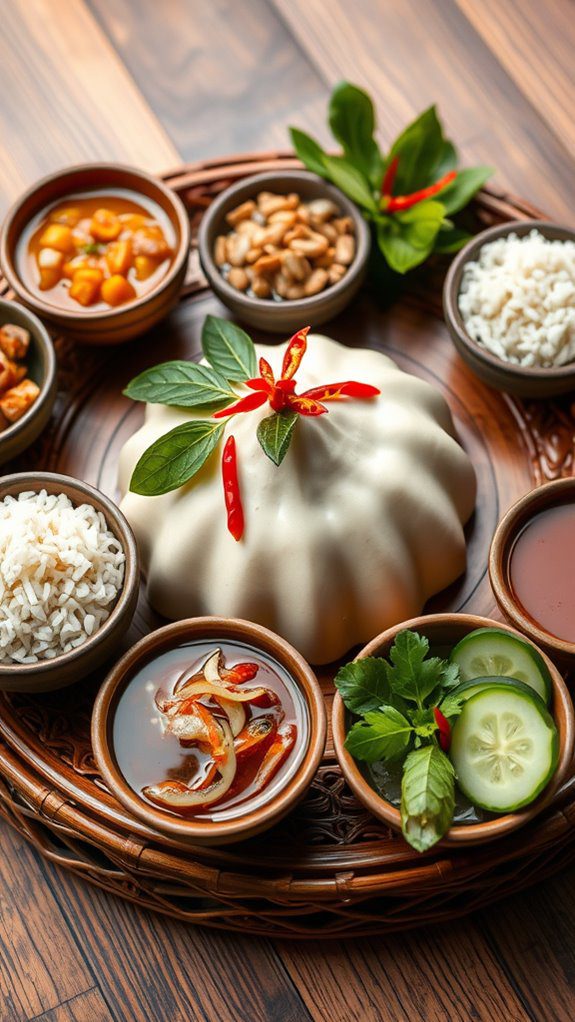
Amok Trey is a traditional Cambodian dish that showcases the delicate flavors of fish steamed in a fragrant, coconut-based curry paste. Known for its smooth and creamy texture, this dish is often served in banana leaves, enhancing its presentation while imparting an earthy aroma.
Ideal for seafood lovers and those who appreciate Asian cuisine, Amok Trey is a delightful option for family gatherings or dinner parties. The preparation time is approximately 30 minutes, with an additional steaming time of about 30 minutes.
Ingredients:
- 500g of white fish fillets (such as catfish or tilapia)
- 1 cup of coconut milk
- 3 tablespoons of fish sauce
- 2 tablespoons of palm sugar
- 2 tablespoons of lime juice
- 2 stalks of lemongrass, finely chopped
- 4 kaffir lime leaves
- 4 cloves of garlic, minced
- 3 shallots, finely chopped
- 1 inch piece of ginger, grated
- 2 teaspoons of turmeric powder
- 1 red chili, finely chopped (optional, for spice)
- Banana leaves or small ramekins for steaming
- Fresh cilantro, for garnish
Cooking Steps:
- Begin by preparing the curry paste. In a blender or food processor, combine the lemongrass, garlic, shallots, ginger, turmeric powder, and red chili (if using). Blend until a smooth paste forms.
- In a mixing bowl, combine the fish fillets, coconut milk, fish sauce, palm sugar, lime juice, and the prepared curry paste. Mix well until all ingredients are well incorporated.
- Cut banana leaves into squares (about 20 cm each) and fold them to create small bowls. Alternatively, you can use small ramekins for steaming.
- Spoon the fish mixture into the banana leaf bowls or ramekins, ensuring they are filled about three-quarters full.
- Place the filled banana leaves or ramekins in a steamer over boiling water. Steam for approximately 30 minutes until the fish is cooked through and the mixture is set.
- Remove from the steamer and carefully unwrap the banana leaves (if used). Serve warm, garnished with fresh cilantro.
Variations and Tips:
- You can substitute the fish with chicken for a different variation, adjusting the cooking time as necessary.
- For a vegetarian option, consider using firm tofu or a mix of vegetables such as eggplant or pumpkin.
- If you prefer a richer flavor, add a tablespoon of shrimp paste to the curry mixture (use less fish sauce in this case).
- Amok Trey pairs well with jasmine rice or coconut rice, providing a perfect balance to the creamy curry.
- To enhance the presentation, you can serve the dish inside the banana leaves, allowing guests to scoop out the flavorful contents at the table.
















